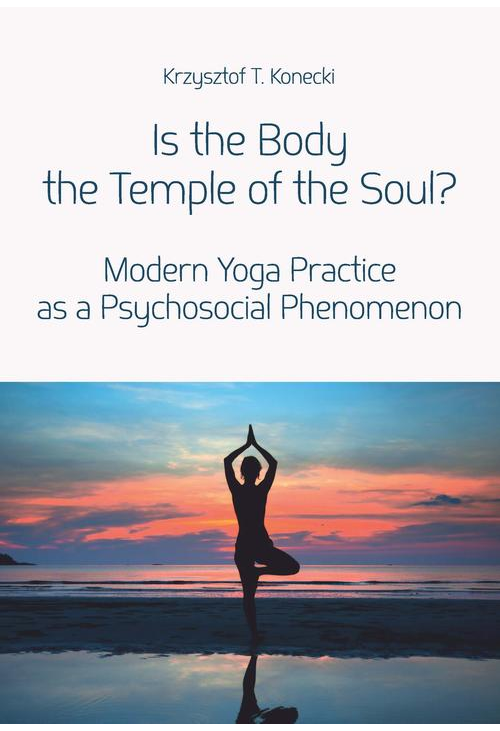
- Za darmo
ebook Is the Body the Temple of the Soul? Modern Yoga Practice as a Psychological Phenomenon
Odkryj głębię hatha-yogi w ebooku "Czy ciało jest świątynią duszy?" autorstwa Krzysztofa T. Koneckiego, wydanym przez Wydawnictwo Uniwersytetu Łódzkiego w 2015 roku. W swoim dziele autor przygląda się tradycyjnej praktyce jogi z perspektywy Zachodu i jej wpływowi na umysł oraz emocje.
Ebook "Czy ciało jest świątynią duszy?" jest doskonałym wyborem dla miłośników literatury pięknej, którzy poszukują wiedzy o jogicznych praktykach i ich filozofii. Publikacja cyfrowa dostępna jest w formacie PDF, co sprawia, że łatwo możesz pobrać ebook do czytania na dowolnym urządzeniu.
Czy jesteś gotowy/a zagłębić się w tajniki hatha-yogi i odkryć, jak praktyka ta może wpłynąć na Twoje zdrowie fizyczne i emocjonalną równowagę? Kup e-booka "Czy ciało jest świątynią duszy?" i wyrusz w fascynującą podróż po świecie jogi, która z pewnością stanie się bestsellerem wśród Twoich ulubionych ebooków.
Spis treści ebooka Is the Body the Temple of the Soul?
Foreword (Michał Szczepanik) 8Introduction 10
Chapter 1. Philosophy and hatha-yoga practice. Para-religious aspects of hatha-yoga 22
1.1. Introduction 22
1.2. Yoga – the perspectives of religious studies scholar and the perspective of yoga practitioner 23
1.3. Yoga and society – “religion of everyday life” 30
1.4. Conclusions 36
Chapter 2. The social world of yoga practice 40
2.1. What is the social world? 40
2.2. Hatha-yoga practitioners and their social world – arenas and legitimization 41
2.3. The intersection of the worlds 49
2.3.1. Intersection of the world of yoga practice and the world of climbing 49
2.3.2. Intersection of the world of conventional medicine and alternative medicine 49
2.3.3. Intersection of the world of business corporations and the world of yoga practice 51
2.3.4. Intersection of the world of yoga and pop-culture 54
2.4. A disagreement about hatha-yoga origin. The vision of Marc Singleton 55
2.5. Conclusions 68
Chapter 3. Commonsense definitions of yoga and its meaning for practitioners 70
3.1. Introduction 70
3.2. Individual interpretations of hatha-yoga 71
3.3. Conclusions 81
Chapter 4. The process of becoming a hatha-yoga practitioner 84
4.1. Introduction 84
4.2. Introductory phase – construction of motives and first steps 86
4.2.1. Constructing motives 86
4.2.2. First steps – beginning of the practice 92
4.2.3. Noticing the effects 99
4.3. The phase of fuller recognition of psychophysical effects, and ascribing appropriate meanings to them 106
4.4. Phase of fuller recognition of the spiritual (para-religious) aspects of hatha-yoga 118
4.5. Conclusions 137
Chapter 5. Visual transmission of knowledge and the meaning of corporality and gestures in the social world of yoga practice 142
5.1. Introduction 142
5.2. The method of studying corporality with the usage of visual techniques 148
5.3. What do I see and feel when I practice? Analysis of the interviews data 151
5.3.1. What do I see when somebody else practices? The analysis of films from the Internet used for interviews 153
5.3.2. What do I feel when I practice? Analysis of the movie-elicited interviews 160
5.3.3. Non-passable knowledge. Difficulties with verbal interpretations and description of asanas 160
5.3.4. Body empathy based on visualization 163
5.4. The role of the teacher and the correctness of asana performance 174
5.5. Conclusions 175
Chapter 6. Emotions and yoga practicing. Working on emotions and achieving “emotional culture” without emotions 178
6.1. Introduction 178
6.2. Working on emotions – explanations based on practitioners’ statements 184
6.3. Conclusions 191
Chapter 7. Teacher and guru in hatha-yoga practice 196
7.1. Introduction 196
7.2. Teacher-student interactions 198
7.3. Conclusions 208
Conclusions 210
Bibliography 218
Szczegóły ebooka Is the Body the Temple of the Soul?
- Wydawca:
- Wydawnictwo Uniwersytetu Łódzkiego
- Rok wydania:
- 2015
- Typ publikacji:
- Ebook
- Język:
- polski
- Format:
- Liczba stron:
- 226
- ISBN dla wersji papierowej:
- 9788379698202
Recenzje ebooka Is the Body the Temple of the Soul?
-
Reviews (0)

Na jakich urządzeniach mogę czytać ebooki?
- Za darmo















@CUSTOMER_NAME@
@COMMENT_TITLE@
@COMMENT_COMMENT@